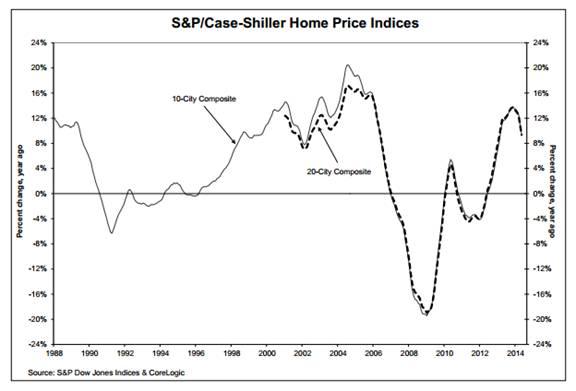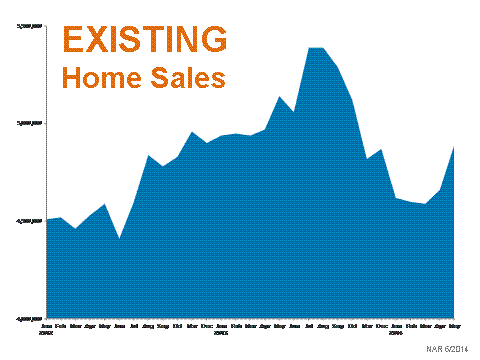Midway through the year, what do the Leading Indicators tell us? This is a strange market if you ask me – the indicators say one thing but the professionals I talk to have a little different take. Let’s start by looking at some of the most popular indicators.
Case-Shiller Home Price Indices – a lagging indicator
The CaseShiller Index gives us a national overview of prices.
“Home prices rose at their slowest pace since February of last year,” says David M. Blitzer, Chairman of the Index Committee at S&P Dow Jones Indices. “The 10- and 20-City Composites posted just over 9%, well below expectations. Month-to-month, all cities are posting gains before seasonal adjustment; after seasonal adjustment 14 of 20 were lower.
“Year-over-year, nine cities – Las Vegas (16.9%), San Francisco (15.4%), Miami (13.2%), San Diego (12.4%), Los Angeles (12.3%), Detroit (11.9%), Atlanta (11.2%), Tampa (10.2%) and Portland (10.0%) – posted double-digit increases in May 2014. The Sun Belt continues to lead with seven of the top eight performing cities. Eighteen of 20 cities had lower year-over-year numbers than last month; San Francisco and San Diego saw their year-over-year figures decelerate by about three percentage points.
“Housing has been turning in mixed economic numbers in the last few months. Prices and sales of existing homes have shown improvement while construction and sales of new homes continue to lag. At the same time, the broader economy and especially employment are showing larger improvements and substantial gains.”
Existing Home Sales – a lagging indicator
According to the National Association of Realtors, total existing-home sales, which are completed transactions that include single-family homes, townhomes, condominiums and co-ops, climbed 2.6 percent to a seasonally adjusted annual rate of 5.04 million in June from an upwardly-revised 4.91 million in May. Sales are at the highest pace since October 2013 (5.13 million), but remain 2.3 percent below the 5.16 million-unit level a year ago.
Lawrence Yun, NAR chief economist, said housing fundamentals are moving in the right direction. “Inventories are at their highest level in over a year and price gains have slowed to much more welcoming levels in many parts of the country. This bodes well for rising home sales in the upcoming months as consumers are provided with more choices,”
This might be the “national view” but I am hearing a different story. In some areas inventory is still very low.
Distressed Property Sales
Because of the rise in home values (and overall improvement in the econonny) we see a natural progression to fewer foreclosures and short sales. In June only 11% of sales were accounted for by distressed properties, the break down was 8 percent foreclosed properties (either at the trustee sale or REO’s) and 3 percent was short sales.
This does indicate that our market is getting back to more healthy, traditional and hopefully predictable cycles.
Pending Home Sales – a forward looking indicator
Pending Home Sales are based on signed contracts not closed contracts. There was a small decline of 1.1 percent to 102.7 in June from 103.8 in May, which is 7.3 percent below June 2013. Despite June’s decrease, the index is above 100 and is considered an average level of contract activity.
All in all this data looks positive with little ebs and flows. I alluded to earlier that professionals in many areas of the country that I speak with are feeling a bit of a stagnation. There doesn’t seem to be a sense of urgency to move.
We’ll take a look at this data again after the prime selling season is over (spring/summer) to see what story that tells us.
This content is intended to provide educational information only. This information should not be construed as individual or customized legal, tax, financial or investment services. As each individual's situation is unique, a qualified professional should be consulted before making legal, tax, financial and investment decisions. The educational information provided in this article does not comprise any course or a part of any course that may be used as an educational credit for any certification purpose and will not prepare any User to be accredited for any licenses in any industry and will not prepare any User to get a job. Reproduced by permission from OTAcademy.com click here for Terms of Use: https://www.otacademy.com/about/terms
Editors’ Picks
EUR/USD eases to near 1.0700 ahead of German inflation data

EUR/USD is paring gains to near 1.0700 in the European session on Monday. The pair stays supported by a softer US Dollar, courtesy of the USD/JPY sell-off and a risk-friendly market environment. Germany's inflation data is next in focus.
USD/JPY recovers after testing 155.00 on likely Japanese intervention

USD/JPY is recovering ground after crashing to 155.00 on what seemed like a Japanese FX intervention. The Yen tumbled in early trades amid news that Japan's PM lost 3 key seats in the by-election. Holiday-thinned trading exaggerates the USD/JPY price action.
Gold price bulls move to the sidelines as focus shifts to the crucial FOMC policy meeting

Gold price struggles to capitalize on its modest gains registered over the past two trading days and edges lower on the first day of a new week, albeit the downside remains cushioned.
Ripple CTO shares take on ETHgate controversy, XRP holders await SEC opposition brief filing

Ripple loses all gains from the past seven days, trading at $0.50 early on Monday. XRP holders have their eyes peeled for the Securities and Exchange Commission filing of opposition brief to Ripple’s motion to strike expert testimony.
Week ahead: FOMC and jobs data in sight

May kicks off with the Federal Open Market Committee meeting and will be one to watch, scheduled to make the airwaves on Wednesday. It’s pretty much a sealed deal for a no-change decision at this week’s meeting.
RECOMMENDED LESSONS
Making money in forex is easy if you know how the bankers trade!
Discover how to make money in forex is easy if you know how the bankers trade!
5 Forex News Events You Need To Know
In the fast moving world of currency markets, it is extremely important for new traders to know the list of important forex news...
Top 10 Chart Patterns Every Trader Should Know
Chart patterns are one of the most effective trading tools for a trader. They are pure price-action, and form on the basis of underlying buying and...
7 Ways to Avoid Forex Scams
The forex industry is recently seeing more and more scams. Here are 7 ways to avoid losing your money in such scams: Forex scams are becoming frequent. Michael Greenberg reports on luxurious expenses, including a submarine bought from the money taken from forex traders. Here’s another report of a forex fraud. So, how can we avoid falling in such forex scams?
What Are the 10 Fatal Mistakes Traders Make
Trading is exciting. Trading is hard. Trading is extremely hard. Some say that it takes more than 10,000 hours to master. Others believe that trading is the way to quick riches. They might be both wrong. What is important to know that no matter how experienced you are, mistakes will be part of the trading process.


